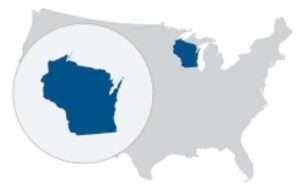“Wisconsin, for the first time in over a decade, we will not have some of the most gerrymandered maps in America,” Evers said.

For the first time since 2011, Wisconsin has state Assembly and Senate maps that do not unconstitutionally favor Republican candidates.
Gov. Tony Evers, a Democrat, signed new legislative maps into law on Monday that were crafted by his office and approved by the state Supreme Court.
“I’ve promised from the beginning that I will always try to do the right thing. Today, I’m keeping that promise and I’m signing fair maps for Wisconsin,” Evers said in a statement posted on social media. “Wisconsin, for the first time in over a decade, we will not have some of the most gerrymandered maps in America.”
“This is a win for Wisconsinites, who for decades have suffered under maps that Republicans gerrymandered to protect their power and allow themselves to obstruct action on popular policies while avoiding accountability at the ballot box.”
Evers said that Wisconsin was a “purple state,” and that its maps “should reflect that basic fact.”
“The people should get to choose their elected officials, not the other way around,” Evers continued.
Wisconsin has been one of the most gerrymandered states in the nation since 2011, when Republican lawmakers redrew the state’s maps under Gov. Scott Walker. In one recent example, the GOP made so many alterations to the 73rd Assembly District in 2022 that residents said it looked like a Tyrannosaurus rex, according to ProPublica.
Fair election groups saw a chance to challenge the maps in August 2023, when the state’s Supreme Court flipped from a conservative to liberal majority with the swearing in of Justice Janet Protasiewicz, who had criticized the maps during her campaign. Advocacy groups and law firms filed a suit on behalf of 19 Democratic Wisconsin voters, and, in December, the court ruled that the maps were unconstitutional because the districts were not “composed of physically adjoining territory” as the state Constitution requires.
The court asked different groups to submit new maps and tasked University of California, Irvine political scientist Bernard Grofman and Carnegie Mellon University political scientist Jonathan Cervas with reviewing them, as Wisconsin Public Radio reported. The experts determined that maps submitted by Evers, the Wisconsin Democrats behind the lawsuit, Democratic state senators, and a group of independent mathematicians were competitive, while two by the state legislature and the conservative Wisconsin Institute for Law and Liberty amounted to gerrymandering. Though Evers’ maps are slightly more favorable to Republican candidates, the court determined that, using his maps, “the party that wins the most votes will win the most seats.”
“The governor’s maps are pretty darn good,” said Jay Heck, the executive director of Common Cause Wisconsin.
The resolution to the fight over Wisconsin’s maps came as something of a surprise, as Republican lawmakers had initially opposed Evers’ maps before introducing them last week and passing them through both the Assembly and Senate. GOP legislators said they decided that the governor’s maps were their best option.
“This fall Republicans will prove that we can win on any maps because we have the better policy ideas for the State of Wisconsin,” Assembly Speaker Robin Vos, (R-63) said, as Wisconsin Public Radio reported.
Most Democrats voted against the maps out of concern that the GOP was not acting in good faith and was in fact preparing a new legal challenge.
“I am voting no because I do not trust what you guys are up to,” Sen. Chris Larson, a Milwaukee Democrat, said, as ProPublica reported.
Good governance groups, however, applauded the development.
“This is a win for Wisconsinites, who for decades have suffered under maps that Republicans gerrymandered to protect their power and allow themselves to obstruct action on popular policies while avoiding accountability at the ballot box,” Chris Walloch, executive director of A Better Wisconsin Together, said in a statement.
Walloch added that Evers’ maps were “a more fair and accurate representation of Wisconsin’s diverse communities than other maps proposed by Republicans” and that they would give Wisconsin voters “a renewed chance for competitive elections and a truly representative government for all.” He also expressed gratitude to the state Supreme Court and Evers for making the new maps possible.
Walloch concluded: “We deserve a legislature that represents us as constituents and prioritizes our best interests. MAGA faction politicians and their special interest allies have gone to great lengths, and great expense, to protect a rigged system that benefited them, and we will continue to hold accountable any politician who attempts to obstruct today’s progress.”
The Democratic Legislative Campaign Committee (DLCC) said they saw the new maps as an opportunity, especially since the entire Wisconsin Assembly and half of its Senate are up for re-election in November, when the new maps will be in use.
“While we still have more work to do to ensure fair representation in each and every Wisconsin community, with these new maps in place, the Democratic Legislative Campaign Committee reaffirms its commitment to reverse the Republican takeover of this state and shift the balance of power in both the Wisconsin Assembly and the Wisconsin Senate,” committee president Heather Williams said in a statement.
“Wisconsin is a top priority for the DLCC in 2024, and we’re already hard at work building the campaigns that will fuel our legislative gains this fall,” Williams continued. “The time for fair representation in Wisconsin is long overdue, and we are building winning campaigns and sustainable infrastructure to build power this cycle and ultimately take back both majorities.”
Common Dream’s work is licensed under a Creative Commons Attribution-Share Alike 3.0 License. Feel free to republish and share widely.
